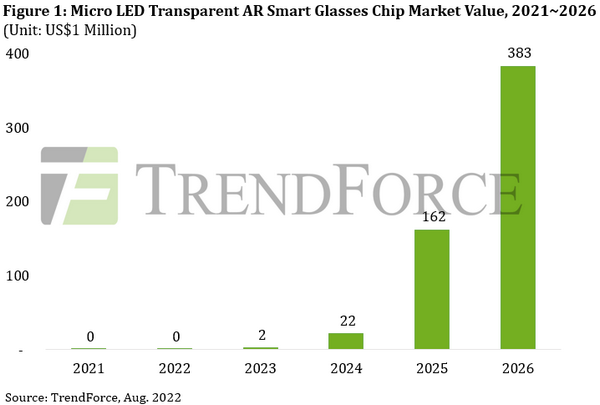Popular Keywords
- About Us
-
Research Report
Research Directory
Semiconductors
LED
Consumer Electronics
Emerging Technologies
- Membership
- Price Trends
- Press Center
- News
- Events
According to TrendForce's latest research report "TrendForce 2022 Self-Emitting Micro LED Display Cost and Trend Analysis," Micro LED light engine performance beats Micro OLED in terms of brightness, contrast ratio, and responsiveness in transparent AR smart glasses microdisplays and is ideal for applications in outdoor environments. Since 2021, more than 10 branded manufacturers around the world have launched Micro LED transparent AR smart glasses concepts and related suppliers have improved Micro LED technology and accelerated factory expansion in order to meet subsequent mass production planning. In 2026, the revenue of Micro LED transparent AR smart glasses chips is forecast at approximately US$38.3 million, with annual compound growth rate of Micro LED chips from 2023 to 2026 at approximately 704%.
However, the current difficulties encountered in the development of Micro LED transparent AR smart glasses mainly arise from optical waveguide technology, light engine technology, battery storage capacity, and image transmission issues. Since transparent smart glasses require high-resolution and high-brightness specifications for outdoor use, Micro LED is the first choice for its light engine. At present, Micro LED light engine technology is not yet mature and the external quantum efficiency of red chips is too low. Problems regarding the miniaturization of microdisplays have appeared one by one. In addition, microdisplay sizes are too small, resulting in small field of view (FOV) so narrow as to affect viewing. If the optical waveguide design method is employed, optical efficiency falls at less than 1%, and incidental light must provide higher brightness to meet the specifications necessary for outdoor use of microdisplays. In addition, transparent smart glasses will need to be worn for a certain period of time. Therefore, battery lifespan and size directly affect product design. Furthermore, another major obstacle is finding a way to integrate the sensor to transmit and process image data.
TrendForce will reveal the current technological progress of various manufacturers in developing transparent AR smart glasses at its Micro LED Forum 2022 on September 13 this year. Many technical fields are focused on the development of optics and light engines. In the field of optics, TrendForce invited Kura Technologies to share their 8K resolution and FOV 150 micro LED transparent AR smart glasses, in a departure from products offered by other manufacturers which can only reach 1080P and FOV 50. In addition, ams-OSRAM will analyze the market segmentation, application standards, and technical challenges of transparent AR smart glasses and discusses the differences between Micro LED micro-projection displays and LBS laser beam scanning display technology.
In the field of light engines, JBD has been aggressively developing light engines for Micro LED transparent AR smart glasses in recent years. JBD announced a large-scale investment and construction plan in 2022 and established long-term strategic cooperation agreements with a number of optical waveguide manufacturers. The company also achieved a major technological breakthrough, producing a Micro LED chip capable of emitting 500,000 nits of ultra-high brightness red light, injecting fresh momentum into the transparent AR smart glasses field. Porotech, a Micro LED chip manufacturer from the UK focusing on AR applications, developed a new porous GaN semiconductor material technology to complete the development of Micro LED red light chips that can improve external quantum efficiency (EQE) to resolve the full color light source issue inherent in transparent AR smart glasses.
TrendForce indicates, as Micro LED light engine and optical technology continues to progress and brands plan new products, there will be prospects to accelerate the advent of a commercial viable Micro LED transparent AR smart glasses product. When the technology and costs are in place, business opportunities will extend from military, medical, aviation, and industrial fields to commercial and comprehensive consumer applications.

For more information on reports and market data from TrendForce’s Department of Optoelectronics Research, please click here, or email Ms. Grace Li from the Sales Department at graceli@trendforce.com
For additional insights from TrendForce analysts on the latest tech industry news, trends, and forecasts, please visit our blog at https://insider.trendforce.com/
Subject
Related Articles
Related Reports

